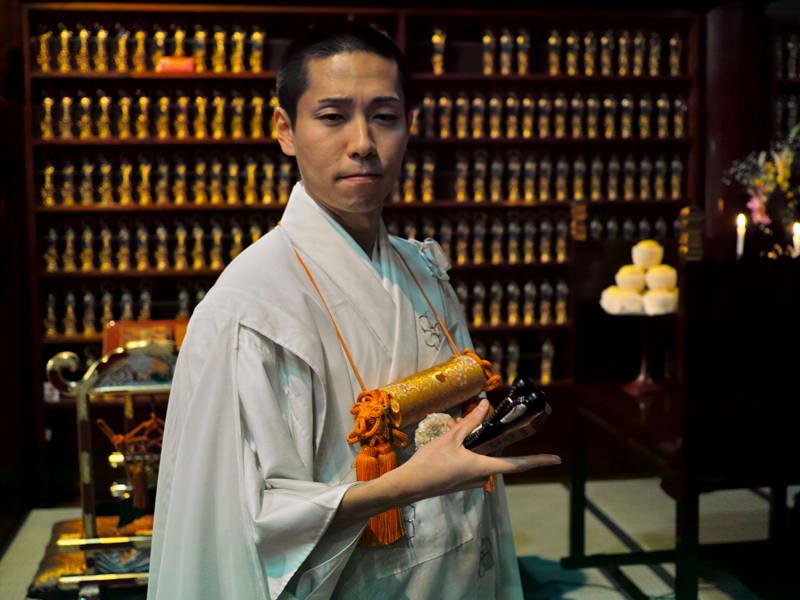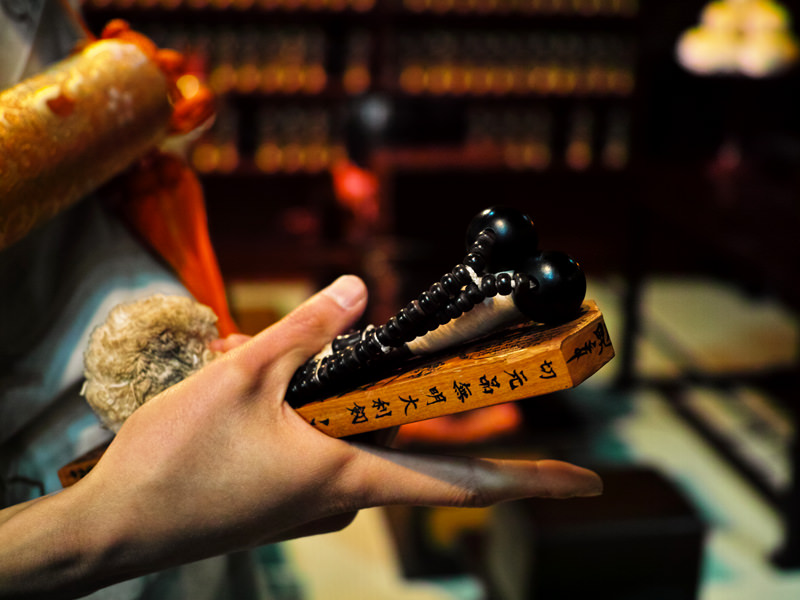Ueno Natives | 上野っ子
關 観哉
Kansai Seki


關観哉さんは上野の名刹・徳大寺の若き僧侶だ。
400年の歴史を持つ徳大寺は、10万人の死者を出した1942年の東京大空襲において上野の中心部で唯一焼け残った寺院である。
この寺は日々何万という人々が日本のみならず世界中から訪れる上野商店街の真ん中に位置し、その特異な景観を浮かび上がらせている。
上野の地は戦災や天災によって何度か壊滅状態になり、「上野の土地は砂の価値と同じ」と言われたこともあった。
關さんは困難を乗り越え、上野の復興を支えてきた人たちと共に暮らすことは光栄なことと言う。
「上野は東京でも一番の文化都市となりました。上野という空間だけで生きていける程、上野という場所には文化的そして日常的な充実があります。上野に住んでいると上野から出なくなりますね」彼は穏やかに微笑む。
元々上野は徳川将軍が拠点とする江戸城を鬼門から守るため開かれた土地だった。
以来、上野は日本にとって国内初の博覧会、動物園、地下鉄、喫茶店といった新しいアイディアを実施するための重要な場所となった。
「ここには昭和初期の文化的華やかさと昭和後期の温もりが混在しているんです」關さんは語る。
「私個人としては上野松坂屋が上野の品を保っていると考えています。もし松坂屋がなければ、上野は今よりもっと雑多になっていたかもしれません」
上野松坂屋は250年の歴史を持つデパートである。
かつては東京の観光名所の一つであり、日本初のお子様ランチはここで生まれた。
松坂屋は戦後日本の明るい希望の象徴であり、高度経済成長期には豊かな暮らしを夢見る人々で賑わった。
そして上野の子供たちの格好の遊び場でもあった。
「私が生まれる前から日本社会はすでに成熟期に入っていました。人々の目が希望に満ちていたその時代の物事に惹かれるんです」
若い頃は上野商店街に住んでいる人たちの顔が見えなかったと彼は言う。
そんな關さんは今、地元の消防団に参加し、その活動を通じて上野の人たちが身近になったと感じている。
「最近は地域活性のための新しい試みもやっているんです。例えばハロウィンには仮装した人たちが徳大寺を訪問できるようにしたりとか」
關さんは物腰の穏やかな人物だが、世界三大荒業と言われる日蓮宗の苦行を堪えた者のみが行うことを許される祈祷法を修めた。
この荒業に参加する僧侶たちは激烈な環境の中で昼夜を問わず修行を行い、睡眠時間はほとんど無いに等しい。
彼らは自らの命を賭して荒業に臨んでいると言っても過言では無いだろう。
「苦行は自分たちに死をすぐそこに感じさせます。その死の恐怖を乗り越えた者のみが苦しみを抱えた人々を救えるのでしょう」
毎日、日々の平安を祈るため地元の人々が数多く徳大寺を訪れる。
高台に位置したこの寺は、地元の守護として上野商店街を見渡している。
将来第33世住職となる關さんは、自分の使命が長きにわたりこの地の人々を見守ってきた徳大寺を守り、次の時代に残すことだと理解している。
「上野は誰でも親しめる土地です。上京してきた人たちも疎外感を持つことはあまりないかもしれません。この街を心地よく魅力的にし続けるためにも、一僧侶としてだけでなく、一市井の者として尽くしていきたいのです」
そう穏やかに言いながら観哉さんはブッダのように優美な手を胸に当てた。
Kansai Seki is a young Buddhist priest of an important temple of Ueno.
His temple “Tokudai-ji” has a history of 400 years, and it is the only temple which remained unburned in the central Ueno in the Bombing of Tokyo that caused 100,000 deaths in 1942.
Tokudai-ji shows its unique appearance in the right middle of the Ueno shopping district where hundreds of thousands people visit not only from Japan but also from all over the world every day.
Ueno had been burned to the ground several times by wars and natural disasters in modern times, and once it had been said that a piece of property in Ueno was equal to a grain of sand in value.
Kansai says that it is his honor to live with people who overcame hardship and supported Ueno’s revival.
“Ueno became the foremost cultural city in Tokyo today. It is a complete place to enjoy both cultural and daily activities. Ultimately I don’t need to go outside Ueno because everything I need can be found here,” he smiles gently.
Originally Ueno was opened as a protection against the quarter lying to the northeast (superstitiously believed to be an unlucky direction) of Edo Castle, the headquarters of the successive Tokugawa shoguns.
Since then Ueno has been a principal district for Japan to carry new ideas into practice; the first Expo, the first zoo, the first subway, the first cafe, etc.
“You still can feel the atmosphere of the days of high culture excitement in 1930’s while walking in today’s popular shopping district,” Kansai explains.
“I personally believe that Matsuzakaya keeps Ueno graceful. Without Matsuzakaya Ueno could be more unorganized than now.”
Matsuzakaya is a department store which has a history of 250 years in Ueno.
It was a place to see in Tokyo in the modern period, the first Japanese kid’s menu at a restaurant was born there.
Matsuzakaya has been a symbol of a postwar bright future, and has been crowded with those who desired wealthy life during the rapid growth of the Japanese economy.
It has also been one of the favorite “playgrounds” of Ueno children.
“Before I was born Japanese society already had entered the period of maturity. I have always had longing for things from those times when people’s eyes gleamed with hope.”
Kansai did not know people in the Ueno shopping district well when he was younger.
Now he joined a local volunteer fire brigade, and got to know the native Ueno people through its activity.
“Nowadays I try working for the good of the local community in new ways. For example I let disguised locals to visit this temple on Halloween as a new enjoyment.”
Kansai is a person with a mild manner, but he has mastered purification prayers that is allowed to do only by who survived an incredible ascetic practice which is recognized as one of the three hardest asceticism in the world.
The ascetic practice goes on for one hundred days in a mountain temple.
Engaged monks perform their practice under extreme circumstances day and night; they have hardly any time for sleep daily.
It is not too much to say that those monks risk death to accomplish their practice.
“The ascetic practice makes us feel death right next to us. Only those who have overcome the terror of death can save people in anguish,” he tells in calm tones.
Every day many people visit Tokudai-ji to pray for their peaceful life.
The temple is in an elevated position, and overlooking Ueno shopping district as a guardian.
Kansai, the thirty-third head priest in the making, understands that his mission is to preserve Tokudai-ji which has been watching over local people through the ages to future generations.
“Ueno is a friendly place to everybody; people away home might not feel alienated. To keep this town always comfortable and fascinating to all, I will do my best not only as a priest, but also as the man in the street.”
So telling he put his Buddha-like graceful hand on his chest.
